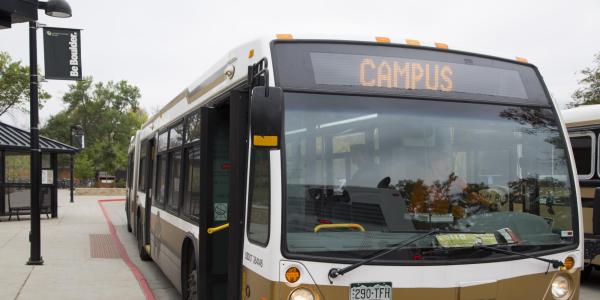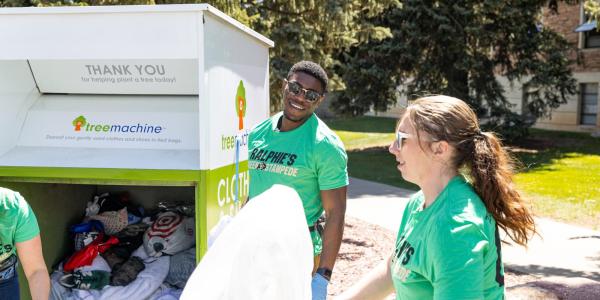The CU Environmental Center, the largest and most accomplished center of its kind in the nation, celebrates its 50th anniversary on April 22, 2020. Founded by students on the inaugural Earth Day in 1970, the E-Center, as it is familiarly known, has helped CU Boulder lead in sustainability among universities nationally throughout the decades. Student ingenuity and passion, supported by staff members, has proven to be a successful model.
When the organizer of the first Earth Day in Colorado, Thomas Mayberry, organized a planning event for Earth Day events on the CU Boulder campus in CHEM 140 in the fall of 1969, he expected a handful of students to come. The packed lecture hall he arrived at on the evening of the meeting showed him the passion and dedication of CU Boulder students for creating a sustainable future. From the students at that meeting came not just a massive Earth Day celebration, but a student board-led organization that harnessed that passion and dedication and turned CU Boulder into one of the most sustainable universities in the nation.
From those student organizers to the student leaders of today, “the Environmental Center has long been one of the greatest allies of CU Boulder's students. Whether it was creating an Eco-Pass program, establishing an on-campus recycling center, or helping the Student Government to become carbon neutral, the Environmental Center has brought action to student calls for sustainability,” says Travis Torline, current CUSG sustainability representative.
“Fifty years ago, gifted and inspired visionaries launched the first Earth Day,” says current Environmental Center Director Dave Newport. “Forward-thinking student leaders on the CU Boulder campus had the vision to launch the CU Environmental Center at that same time. The work of that center has gone on to this day, and we are certainly not done yet.”
The 1970s: Initiation and infrastructure
Many of the students in CHEM 140 that day had already been organized around environmental issues. With the impetus and momentum of Earth Day, they came together to found the ECO-Center, which later changed to Environmental Center, on the first Earth Day in 1970. The following year, students passed a student referendum which allocated $1 per student in student fees to environment-related university projects. A board was created to oversee the fund when it took effect the following year, 1972.
The fees were initially distributed between multiple student groups, as well as allocated to a newspaper recycling project which eventually became CU Recycling. In 1974, the first non-student director of the Environmental Center was hired, which helped to manage the burgeoning suite of nascent programs and partnerships. By the end of the decade, the first full-time staff director was brought on to lead a well-organized center with transportation and recycling and a grant fund for new environmental campus initiatives.
The 1980s: Bringing global issues to campus
CU Recycling operations, which grew throughout the decade including through the acquisition of trucks for hauling, developed into one of the largest campus recycling programs in the country by mid-decade. Partnerships with the City of Boulder began in the mid-1980s, bringing recycling education on campus and to providing home energy efficiency devices. National conferences on a wide variety of environmental concerns—hosting speakers such as David Brower and Amory and Hunter Lovins—were held throughout the decade, as well as a weekly film series and discussions.
The 1990s: Town-gown partnerships expand
A decade of big changes kicked off with the creation of the Solid Waste Advisory Board (now called the Zero Waste Board of Directors) in 1990 and the Student-Administration Partnership for Recycling and the Student Bus Pass program in 1991. Student ridership on RTD buses dramatically increased, allowing the City of Boulder to create now-beloved bus lines like HOP, SKIP, and JUMP. The success inspired other campuses around the country to create similar programs.
The campus Intermediate Processing Facility, where students sorted most recyclable materials collected on campus (now done at the Grounds Operations Recycling Center), was completed in 1992, funded by a loan from the chancellor that was paid back with the subsequent reductions in trash fees. By the end of the decade, over 1,000 tons of materials were being collected and recycled on campus annually.
The 2000s: Campus embraces sustainability
The Environmental Center published a Blueprint for a Green Campus in 2000, many of the ideas and plans from which were eventually implemented or included in the campus-wide Conceptual Plan for Carbon Neutrality published in 2009. The first Bike Station on campus opened in 2004 just east of the University Memorial Center, and was later moved to the UMC Fountain when ATLAS and the Visual Arts Center were built. In 2005, students voted to fund a grant program that would finance sustainable campus improvements. The first campus event held as a zero waste event happened in 2005, ushering in a tradition of zero waste events and programs on campus. The CU Green Labs Program, a partnership between Facilities Management and the Environmental Center, started in 2009 to minimize the use of energy, water, material goods, and hazardous chemicals in CU Boulder laboratories and promotes efficient, effective use of research equipment and laboratory space. These efforts were recognized by the Sierra Club in 2009, when it ranked CU Boulder the nation’s number one “eco-friendly university.”
The 2010s: New programs lead change
CU Boulder’s dedication to sustainability was recognized nationally when CU Boulder was the first campus in the nation to receive a Gold rating in the Sustainability Tracking, Assessment & Rating System (STARS), a global sustainability standard created by and for higher education. Ralphie’s Green Stampede, which helped CU Athletics launch the first NCAA Division I zero-waste stadium program when it began in 2008, expanded to include all gameday facilities in the 2010s. The PIPs Rewards Program, a mobile app that rewards students for actions that reduce consumption and support wellness and social good, began as a pilot at CU Boulder in 2017.
The Future
As the unjust societal impacts of a destabilizing climate and biosphere are increasingly apparent, the Environmental Center is integrating a strategic focus on equity and inclusion into all of its programs and operations.
“The Environmental Center has never shied away from the issues of the day,” said longtime CU Recycling Development Director Jack DeBell, who started with CU Recycling as a first-year student in 1979 when recycling itself was rare.
“The next 50 years of the Environmental Center and of our campus community as a whole is an opportunity for critical engagement: to lean in, listen, and take action. The climate crisis is a social justice crisis, and that will be forefront in our minds as we collaboratively pursue the necessary solutions, such as achieving CU Boulder's carbon neutrality goals. Student activism has always played a role on CU's campuses and, as the youth led global climate strikes have reinforced, student leadership will continue to be a powerful force for change during this next chapter,” according to current Environmental Board co-chair and engineering student Abigail Weeks.
Newport says that as the Environmental Center looks to the future, it will be the vision and action of students that continues to propel its work.
“Ironically, CU students come here to learn—but they teach us new directions. For five decades, students’ conscience and foresight have informed our campus and community’s ethos. Today, a next gen Earth Day operating system must encode students’ ethical purpose, profound social justice and a circular economy to prosper past our unprecedented challenges. We must stand students on our shoulders if we are to see further.”



